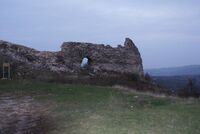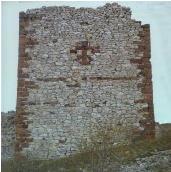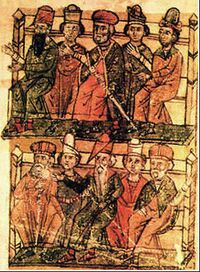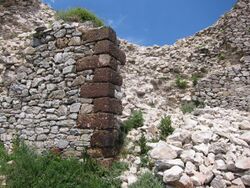Social:Novo Brdo Fortress
Novo Brdo Fortress (Serbian: Тврђава Ново Брдо, Tvrđava Novo Brdo; Albanian: Kalaja e Novobërdës or Kalaja e Artanës) is a medieval Serbian fortress in Kosovo.[lower-alpha 1] Its ruins are located near the town of Novo Brdo, about 40 kilometres (25 mi) east of Pristina. The fortress was built in the late 13th century by king Stephen Uroš II Milutin of Serbia to protect gold, silver, iron and lead mines which were abundant throughout the area. Novo Brdo was famous for its silver. Together with the castles of Prizrenac, 12 kilometres (7.5 mi) to the southwest, and Prilepac, 13 kilometres (8.1 mi) to the southeast, which guard access roads to the fortress, Novo Brdo helped form a defensive complex overlooking the lucrative mining operations. Novo Brdo was at its height during the Serbian Despotate (1402–1459), when it was the most important mining area and second most important town in Serbia. A significant number of Saxon miners and a large Ragusan merchant colony lived within the town, which was ruled by a vojvoda, but also a governor (kefalija), because it was the seat of an administrative unit of the Despotate.[1]
For its fortress and production of silver and gold, Novo Brdo has been referred to as the "Mother of all Serbian cities",[2] a "mountain of gold and silver",[3][4] and the "strongest fortification of Serbia".[5] Systematic archaeological research of the site began in 1952. Novo Brdo Fortress was declared a Monument of Culture of Exceptional Importance in 1948.[6] After Kosovo's unilateral declaration of independence from Serbia in February 2008, the site was established as a Special Protective Zone of Kosovo.[7] Remains of fortifications, buildings, and mining facilities are scattered throughout the area. Constant illegal digging to find buried treasure, plundering, and amateur excavations are destroying valuable archaeological strata.[8]
Etymology
Novo Brdo means New Hill in Serbian. Other names for Novo Brdo in written sources are either translations or are derived from the name in Serbian. Some of them are: Nowobordo, Nowebordo, Novus Mons, Novomonte, Monte Novo, Nyeberghe, Novaberde, Νοβόπριδον.
Layout
Novo Brdo Fortress consists of two parts:[9] the Upper Town and the Lower Town. It is composed of eight rectangular towers (six in the Upper Town and two in the Lower Town), three gates (one in the Upper Town and two in the Lower Town), and a large dry moat around most of the walls (from the north point of Upper Town to the north point of Lower Town to the south point of Lower Town). Upper Town has an irregular hexagonal shape. Lower Town fans out toward the west down the slope of the hill. The dry moat wraps around the fortress from the west to the north. There is a source of drinking water inside the fortress. Vast suburbs (Serbian: Подграђе) outside the city walls expand to the east and southeast. Settlements of Sass miners and merchant colonies of traders from Dubrovnik were located in the suburbs, as well as merchants from the Italian city-states, especially Venice.
Upper town

The Upper Town is the citadel of Novo Brdo and has a nearly regular hexagonal shape that is flattened on the east, so it almost takes on the look of a pentagon with the flat side facing outward toward the direction that is most approachable. In the middle of the flattened portion is the large rectangular four-sided donjon tower. Opposite the donjon in the western vertex is a three-sided tower, its curved side adorned with a cross in dark red brick facing the Lower Town and the west. In each of the remaining vertices are square towers. The entrance to the Upper Town was through a pedestrian gate in the rampart between the tower with the cross and the tower to the south of it. The length of Upper Town (in the north-south direction) is 50 metres (160 ft), while its width is 45 metres (148 ft).
Lower town
Lower Town is a fortified settlement of Novo Brdo in the shape of an elongated rectangle (180 m x 95 m, of which 45 m belong to Upper Town) with flattened sides (at the east and west). Lower Town consists of only two complete vertices (each with a tower), while the remaining two vertices are actually arched ramparts (west) and Upper Town (East). The main entrance to the Lower Town is the great cart gate with a ramp, which is located in the southeast rampart alongside the south tower of the Upper Town. In the north wall near the north tower of the Lower Town is a pedestrian gate which was used for sallies during the siege.
Towers
Novo Brdo has eight towers – six in the Upper Town and two in the Lower Town:
- A rectangular tower at the eastern vertex of the Upper Town, the donjon of the fortress;
- A three-sided square tower at the northern vertex of the Upper Town, from which starts the northeast rampart of the Lower Town;
- A three-sided square tower at the northwestern vertex of the Upper Town;
- A three-sided rectangular tower at the western vertex of the Upper Town decorated with a cross made of dark red stone with an inscription – I-H К (А) – made of brick;
- A three-sided square tower at the southwestern vertex of the Upper Town;
- A three-sided square tower at the southern vertex of the Upper Town;
- A polygonal triangular tower at the northern vertex of the Lower Town; and
- A polygonal triangular tower at the southern vertex of the Lower Town decorated with three rose windows. The first window, with a diameter of 70 cm, is on the south side of the tower close to the eastern rim in the upper part of tower – it is very similar to the western rose window of the Ravanica monastery. Two additional windows are on the east side of the tower and are slightly smaller than the first; these windows resemble the rose window in the Ljubostinja monastery (north facade, western part, near the side apse).[9]
Gates
Novo Brdo has three gates, one in the Upper Town and two in the Lower Town:
- The arched pedestrian gate located in the western rampart of the Upper Town between the west tower with the cross and the southwest tower;
- The great cart gate with a ramp located alongside the south tower of the Upper Town; and
- The arched sally port located in the northeast rampart of the Lower Town near the north tower.
Religion
Within mining settlement of Novo Brdo there are seven Eastern Orthodox churches and two Roman Catholic churches, most important being:
- Eastern Orthodox church of Saint Nicholas, that was main city church, and was used by Eastern Orthodox Serbs
- Roman Catholic church, which is referred to as Santa Maria de Nuovomonte in Dogni Targ (Saint Mary of Novo Brdo in Lower Square), also known as Sass's church, used by Sass miners and merchants from Dubrovnik (located at present day village of Bostan).[11]
- The "Church of the Saxons", another Catholic church which was dedicated to Saint Nicholas.[12]
Religious life in medieval Novo Brdo was characterized by the coexistence of Roman Catholic and Eastern Orthodox communities. Novo Brdo was one of the primarily Catholic settlements of Serbian Despotate.[13] Albanian Roman Catholics, Ragusan merchants, and Saxon miners formed the bulk of the Catholic community of Novo Brdo. In the local registers, names of various priests that served the community have survived, such as the Albanian Ginus filius Georgii de Nouaberda and the Ragusan Pasko Bobaljević eanonieus Ragusii et plebanus Novi Montis.[12]
Life in medieval Novo Brdo
Novo Brdo was a scattered town, a huge mining settlement, and a suburb of Novo Brdo. The square (mercatum or burgus), the heart of social life, was located here. It had its own statute (law), at least since 1439. Due to large amounts of high-quality silver, trade ties of Novo Brdo extended far beyond the Balkan peninsula, especially to the west across the Adriatic sea to Italy and beyond. Suburbs extended to the rivers Kriva reka (which was known as Topolnica at the time) and Prilepnica. The approach to Novo Brdo was defended by castles in Prizrenac and Prilepac. Contemporary sources also mention the existence of a hospital owned by the Catholic church.[12]
The mining work force consisting mainly of Sass valturci or rupnici (miners). Lively trade was conducted in the square, mostly by merchants from Dubrovnik and Venice, but also by Sass purgar (citizens). Sass had its own civil court, notaries, urburare (accountants that took care of mining tithe), and church. The Novo Brdo miners were so famous in Europe for their advanced skills that in the 14th and 15th centuries they were invited to move to and work in Italy and Spain.
Novo Brdo mines in the 15th century were especially known for the production of glam silver (argentum de glama), a type of silver containing up to 33% gold. Merchants of Dubrovnik sought to purchase this ore at the price of ordinary silver, then refine the gold themselves, and gain enormous profits. According historical estimates, the mines of Novo Brdo produced up to 6 tonnes of silver annually.
When the Nemanjić dynasty first took control of the area in the 12th century, settlements were built on hilltops and in strong defensive positions against attacks by rivals or local peasants – but when the Ottomans took control of the area in the 15th century there was less need for this and towns developed in the valleys instead.[14]
History
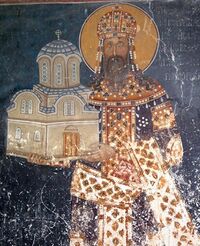
Significant mining activity in Novo Brdo began in the first half of the 13th century during the reign of Serbian King Stefan Vladislav (r. 1233–1243), who had brought Saxon miners ("Sasi") to Serbia and developed mines.[15] The fortress of Novo Brdo was created during the early years of the reign of king Stephen Uroš II Milutin of Serbia (r. 1282–1321) and became one of the most important settlements of Sass miners (they called Novo Brdo Nyeuberghe). Novo Brdo was also known as the Place of the Sasi (Serbian: Сашко место).
Novo Brdo appears in historical records in 1325, already renowned as a mining and trading center in which Ragusan traders conducted trade and had a customs office and a consul. In a letter from that year, King Stefan of Dečani informed the government of the Republic of Ragusa that the lease for the use of the Novo Brdo mine had been paid in full by Ragusan merchants.
Silver coins (grossi di Novaberda) carrying the insignia "Nouomonte moneta argentea" were made in Novo Brdo beginning in 1349 by Prince Lazar Hrebeljanović (r. 1373–1389).[16] Novo Brdo's glam silver (argentum de glama) was much sought after by Ragusan traders.[17] The significance of Novo Brdo is further documented by the number of late medieval luxury goods findings, which speak about its prosperity and high status.[18]
Serbian rulers had a custom of donating a certain amount of silver from Novo Brdo to various monasteries: Prince Lazar to Ravanica and Drenča, Despot Stefan Lazarević (r. 1389–1427) to Hilandar and Great Lavra, and Despot Đurađ Branković (r. 1427–1456) to Esphigmenou. In 1405, Despot Stefan donated an annual income of 100 pounds of silver from Novo Brdo to the Hilandar monastery. The law of the city of Novo Brdo is mentioned in 1439, which indicated that Novo Brdo in the 15th century was organized as a city municipality.[2] Production of silver and gold peaked between 1420 and 1440.[19]
The Ottoman Empire tried to capture Novo Brdo in 1412, but after a long siege they were forced to retreat. They then shifted their activity in Novo Brdo to intercepting caravans from Ragusa, attempting to deny them access to the town, but the town remained mainly undisturbed. Despot Stefan Lazarević ratified a set of laws on mining, the Sasi community, and exploitation of the mines in 1412.[20] An archery tournament was held in 1413.[16] After the first collapse of the Serbian Despotate in 1439, the Ottomans began a long siege of the fort, which ended with surrender of the Serbian defenders on 27 July 1441. Although the rest of Serbia was under Ottoman occupation for more than a year, during the two-year siege the residents of Novo Brdo stubbornly defended and even launched two attacks to repel the Ottomans, but were unsuccessful and lost the battles of Gračanica on 6 August 1439 and Makreš in 1440. In the first half of 1441, the Ottomans managed to take the suburbs of Novo Brdo. The town's defenders continued to resist until the end of June, when they surrendered.[21] The Ottomans then plundered and burnt the town.
After a successful crusade in 1443–44, which penetrated all the way to Sofia and led to the restoration of the Serbian Despotate under the terms of the Szeged peace treaty, Novo Brdo was returned without a fight to Despot Đurađ Branković. Under Đurađ's vassal obligations towards the Ottoman sultan, a detachment of cavalry and a company of tunnel diggers from Novo Brdo were sent to Mehmet II (1451–1481) to aid in his attack on Constantinople, which ended on 29 May 1453 with the city's fall.[22] According to the account of Bertrandon de la Broquière written in 1433, Đurađ was receiving 200,000 ducats out of Novo Brdo annually,[23] while Novo Brdo mines were the most prosperous in the whole Balkan peninsula.[19] At the time, annual income from the town was around 120,000 ducats. In 1454 the great voivode of Novo Brdo was Alessio Spani, a son of Peter Spani of the noble Albanian Spani family of Greek origin.[24] Alessio's father Petar was also voivode of Novo Brdo under Stefan Lazarević.[25][26]
In 1455, the Ottomans attacked Novo Brdo again, and with the use of heavy artillery, forced the besieged to surrender on 1 June 1455. Under the orders of Sultan Mehmed II, all men of any distinguished rank or importance were decapitated. An estimated 320 boys were taken to become janissaries (devşirme). Approximately 700 girls and young women were taken to serve as the wives of Ottoman soldiers and their commanders.[27] The siege and its aftermath were described in Memoirs of a Janissary, written in 1490—1501 by Novo Brdo resident Konstantin Mihailović, who was one of the boys taken.
Exploitation of the surrounding mines continued under the Ottomans, though operations were significantly diminished due to the lack of a professional work force and deteriorating conditions that had caused a steep decline of the town since 1455. According to defters for 1477 and for the period from 19 August 1498 to 7–8 August 1499, Novo Brdo was a completely Christian town, without a single Muslim, and contained 887 homes in total, out of which 78 were new. Of the approximately 5,000 inhabitants, 73 were miners and craftsmen. A defter for the Vučitrn sanjak, dated 4 January 1526, registered 514 homes, of which 139 were Muslim.[28]
From the 17th century, mintage was renewed in the fortress during the reign of sultan Murad IV (1623–1640), but was stopped in 1651. At the time there were only 18 Roman Catholic homes with 70 Roman Catholics left, and both Roman Catholic churches were so damaged that the priest held mass in one of the houses. In 1685, there were only 10 houses left in the fortress, which was so ruined by then that the 40 janissaries of the garrison were stationed in suburbs, which contained only 150 Christian and Muslim homes.[2]
During the Great Turkish War, with the help of local Serbian rebels, general Enea Silvio Piccolomini occupied Novo Brdo in 1686, only a year after it was abandoned. In 1690–91, under the leadership of the Serbian Patriarch Arsenije III Čarnojević (1672–1706), the local Serbs moved to the Habsburg Monarchy during the Great Serb Migration. The Ottomans reclaimed the fortress later that year, killing the entire Austrian garrison that had been left behind by Piccolomini. Afterwards, the exploitation of Novo Brdo mines and the use of the nearby fortress and adjoining settlements ceased. The fortress suffered significant damage in 1892, when the Ottomans used its well-made stones to build barracks in Pristina.
Systematic archaeological research of the site started in 1952 by the Archaeological Institute of the Serbian Academy of Sciences and Arts. In 1957, the National Museum of Serbia joined the research. Endeavors resulted in a number of multidisciplinary studies.[29] Research was discontinued in 1999, due to the NATO bombing of Yugoslavia. Amateur excavations, treasure hunting, plundering, and illegal diggings, almost constant since 1999, continue to deteriorate the site.
See also
- List of fortresses in Kosovo
Notes
Notes:
- ↑ Kosovo is the subject of a territorial dispute between the Republic of Kosovo and the Republic of Serbia. The Republic of Kosovo unilaterally declared independence on 17 February 2008, but Serbia continues to claim it as part of its own sovereign territory. The two governments began to normalise relations in 2013, as part of the 2013 Brussels Agreement. Kosovo is currently recognized as an independent state by 98 out of the 193 United Nations member states. In total, 112 UN member states recognized Kosovo at some point, of which 14 later withdrew their recognition.
References
- ↑ fakultet, Univerzitet u Beogradu. Filozofski (1968). Zbornik Filozofskog fakulteta. Naučno delo. p. 239. https://books.google.com/books?id=3CQkAQAAIAAJ.
- ↑ 2.0 2.1 2.2 Kostić 1922
- ↑ Радојчић (1962). pp. 6"Nowobordo Gora Srebrna i Złota" and "Nowebordo, gdzie jest gora srebrna i złota"
- ↑ Critobulus, De rebus gestis Mechemetis II. inde ab anno 1451 usque ad annum 1467
- ↑ Kostić 1922, John of Capistrano, in a letter of 21 June 1455 to Roman pope Callixtus III: "Turkish emperor Muhammad took the strongest Serbian city called Novo Brdo, where are mines of gold and silver, that brought their master despot Đurađ income of 120,000 ducats per year."
- ↑ Monuments of Culture in Serbia: ОСТАЦИ СРЕДЊОВЕКОВНЕ ТВРЂАВЕ СА ПОДГРАЂЕМ (SANU) (in Serbian and English)
- ↑ "Implementation of Special Protective Zones for Religious and Cultural Heritage in Kosovo". International Civilian Office. September 2011. p. 3. http://www.ico-kos.org/data/Image/SPZ_Progress_Report_Final_EV.pdf. Retrieved 31 March 2013.
- ↑ Alma Lama, "Foreign Raiders Plunder Kosovo's Heritage", BCR Issue 561, 2 August 2005
- ↑ 9.0 9.1 Бошковић 1939
- ↑ Дероко 1950, p. 170
- ↑ Zdravković I., Simić Μ., "Manje crkvene građevine i zgrade iz turskoga doba na Novom Brdu", Glasnik Muzeja Kosova i Metohije, I, 1956, 245—74. (in Serbian)
- ↑ 12.0 12.1 12.2 Gjini, Gaspër. Ipeshkvia Shkup-Prizren nëpër shekuj. Diocese of Skopje-Prizren. p. 81. http://famulliabinqes.com/kulture/Ipeshkvia%20Shkup%20Prizren%20neper%20shekuj.pdf.
- ↑ Oliver Jens Schmitt, ed (2010). Religion und Kultur Im Albanischsprachigen Südosteuropa. Peter Lang. p. 18. ISBN 9783631602959. https://books.google.com/books?id=aCdYHU9PtiIC&pg=PA18. Retrieved 7 April 2013. "Before the Ottoman conquest Novo Brdo was a Catholic stronghold; from the late 15th century on it was included in the Orthodox ecclesiastical organisation of the Ohrid Archbishopric"
- ↑ Judah. The Serbs. Yale University Press. pp. 5–10. ISBN 978-0-300-15826-7.
- ↑ Радојчић Н., "Одакле је Јован Рајић преузео вест ο отварању рудника у Србији за време краља Владислава?", Прилози за књижевност, језик, историју и фолклор, XXV, 1959, 248—55. (in Serbian)
- ↑ 16.0 16.1 Дероко 1950, p. 171
- ↑ Јиречек К., "Рударство у Србији и Босни у средњем вијеку", Отаџбина, IV, 1880, 436—438 (in Serbian)
- ↑ Zečević Emina, "Glass of Novo Brdo and its significance in Late Medieval glass production", ANNALES du 18e CONGRÈS de l’ASSOCIATION INTERNATIONALE pour l’HISTOIRE du VERRE, 2012 Thessaloniki International Association for the History of Glass and authors, 27th Ephorate of Prehistoric and Classical Antiquities, Greece.414–418, ISBN:978-90-72290-00-7
- ↑ 19.0 19.1 Desanka Kovacevic , "Les mines d'or et d'argent en Serbie et Bosnie", Annales. Économies, Sociétés, Civilisations. 15e année, N. 2, 1960. pp. 248–258. (in French)
- ↑ Радојчић, Никола (1962). pp. 20
- ↑ Vojislav Jovanović (2004) (in sr). Novo brdo. Republički zavod za zaštitu spomenika, Beograd. pp. 58. ISBN 86-80879-32-0 (in English)
- ↑ Siniša Mišić (2010) (in sr). Leksikon gradova i trgova srednjovekovnih srpskih zemalja : prema pisanim izvorima. Zavod za udžbenike, Beograd. pp. 199. ISBN 978-86-17-16604-3
- ↑ Гласник Српског ученог друштва, XXVI, 1869, 217–218. (in Serbian)
- ↑ Glas. Srpska akademija nauka i umetnosti. 1983. p. 72. https://books.google.com/books?id=Uq0rAQAAIAAJ.
- ↑ Denkschriften. In Kommission bei Alfred Hölder. 1920. p. 26. https://books.google.com/books?id=_jk9AAAAMAAJ. "... in Novo Brdo Peter und Alexius Petri Span 1454"
- ↑ Чупић, Никола (1900). Годишњица Николе Чупића. Штампа Државне штампарије Краљевине Југославије.. p. 41. https://books.google.com/books?id=Cmg6AQAAIAAJ. "Тако за време Деспота Стевана беше војвода новобрдски неки Петар, на кога се у једном писму жале Дубровчани деспоту Стевану,"
- ↑ Dusan T. Batakovic, "Kosovo and Metohija Under the Turkish Rule"
- ↑ Радојчић, Никола (1962). pp. 16
- ↑ Радојчић, Никола (1962). pp. 10
Sources
- Дероко, Александар (1950) (in sr). Београд. pp. 170–173
- Иван Здравковић, „Средњовековни градови и дворци на Косову“, Београд, 1975. (in Serbian)
- Радојчић, Никола (1962) (in sr). Српска академија наука и уметности, Научно дело, Београд. http://www.monumentaserbica.com/nik_mushushu/story.php?id=1016
- Бошковић, Ђурђе (1939). Ново брдо. Бановинска штампарија, Скопље. http://www.rastko.org.rs/istorija/srednji/djboskovic-brdo.html; Đurđe Bošković, "La Forteresse Novo Brdo", Skoplje, 1939. (in Serbian) (in French)
- Kostić, Kosta (1922) (in sr). Naši novi gradovi na jugu – Novo Brdo. Srpska književna zadruga, Beograd. http://sr.wikisource.org/sr-el/%D0%9D%D0%B0%D1%88%D0%B8_%D0%BD%D0%BE%D0%B2%D0%B8_%D0%B3%D1%80%D0%B0%D0%B4%D0%BE%D0%B2%D0%B8_%D0%BD%D0%B0_%D1%98%D1%83%D0%B3%D1%83#.D0.9D.D0.9E.D0.92.D0.9E_.D0.91.D0.A0.D0.94.D0.9E.
External links
- Novo Brdo at the Association of Fortresses
 |
